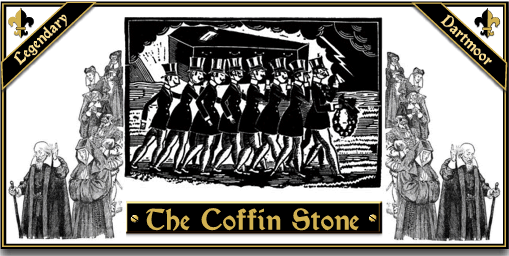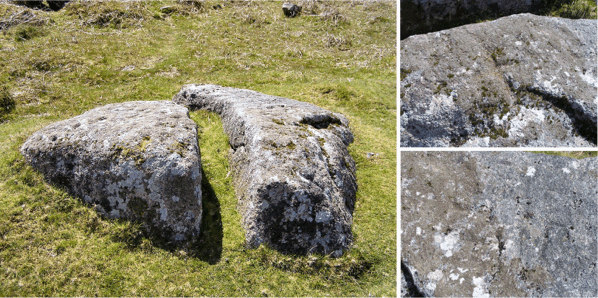
It was a dark dreary Dartmoor day in which a small funeral procession could be seen slowly making its way up Dartmeet hill. The coffin bearers were beginning to tire. Privately some of them were thinking why on earth they should be struggling up this monster of a hill carrying the mortal remains of what was one of the most unpopular men on the moor. Some said the departed soul was utterly evil, he was a terror to his neighbours and made their lives a living hell. But the moorman’s respect for the dead meant that the old tyrants remains had to be carried to Widecombe for burial. The sky darkened and the wind began to strengthen as the party toiled on. The silence only broken by the cawing of a passing raven, its heavy wing beats made an eerie ‘whoomping’ sound as if beating a slow tattoo for the procession to walk to. The heavy coffin was cutting deep into the shoulders of the pall bearers, the rough wood was chafing their hands and still they toiled onwards. Each one was spurred on by the thought that soon they would reach the Coffin Stone and would be able to unburden themselves and take a well deserved rest. It was a Dartmoor tradition that funeral processions would rest the coffin on this large granite boulder. In some cases if the departed soul was well liked the men would carry a hammer and chisel and carve their initials on the rock. This certainly was not going to be the case with this particular departed soul. The bearers also knew that tradition had it that a bottle of whisky would be produced and a small ‘tot’ was partaken of in remembrance of the dead. This they were looking forward to as it would warm their chilled bodies and hopefully restore some vigour for the remaining journey. The party sped up as the famous old boulder came into sight. With a mighty heave the men hoisted the coffin off their shoulders and lowered it onto the granite slab. The very minute the wooden box touched the Coffin Stone a brilliant white bolt of lightening flew down from the heavens. The moorfolk dived for cover as it struck the coffin and engulfed it in a blazing inferno. As the fire died down it was plain to see that not only had the coffin and corpse been consumed by the flames the Coffin Stone had been split in two. Consensus of opinion led to the view that this was a sign from the Almighty who was not going to allow such an evil man to be buried in His holy cemetery. So having no corpse to bury they held with tradition and all partook of some whisky and then hurried off home in order to place as much distance between them and the smouldering rock.
The Coffin Stone is still in place beside a well worn track. The rock clearly has been split but this can be attributed to frost rather than divine thunderbolts. Many topographical writers relate about the custom of resting coffins on the stone. Although barely visible today there are several incised marks on the rock. Crossing states that higher of the two stones has nine incised crosses and the initials SI, SC and AC. The lower stone has two incised crosses and the initials IB and IP. It is thought that ‘SC’ represents Samuel Caunter and AC denotes Aaron Cleave, as to the rest nobody seems to know. It appears that the actual incisions were made during the traditional rest and libation at the stone which meant a hammer and chisel would have been carried by one of the mourners. In her book ‘From a Dartmoor Window’ Beatrice Chase relates how sometime in the early 1900’s she was told of a recent burial procession of 90 bearers who stopped at the Coffin Stone. She also says that two of the bearers were brothers and when the procession reached Widecombe church an old woman berated the men for breaking the Dartmoor taboo whereby if two blood relations carried a coffin together one of them would die. It seems this ‘old wives’ tale amused the brothers no end but sure enough one of them suddenly died a week later and his coffin was placed on the old stone.

The Coffin Stone and some of the incised markings – May 05
The easiest way to find the stone is to park in the large car park by Yar tor and then walk downhill on the obvious track towards Dartmeet, keeping the road to your right. About halfway down the rock is on the left hand bank.
 Legendary Dartmoor The many aspects past and present of Dartmoor
Legendary Dartmoor The many aspects past and present of Dartmoor

3 comments
Pingback: Mythes et légendes de Dartmoor : Les Cercles de pierre grise de wethers (vidéo) | Etrange et Insolite
Pingback: Mythes et légendes de Dartmoor : La tombe de Kitty Jay (vidéo) | Etrange et Insolite
Pingback: Mythes et légendes de Dartmoor : Cutty Dyer | Etrange et Insolite